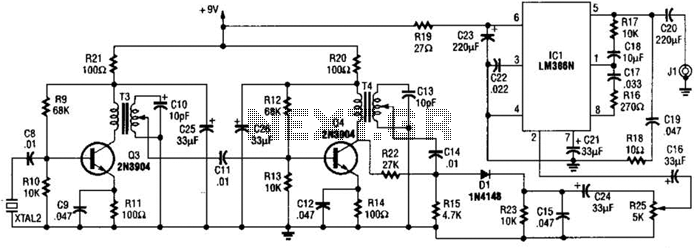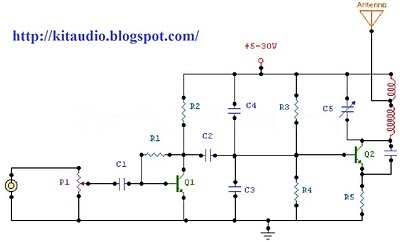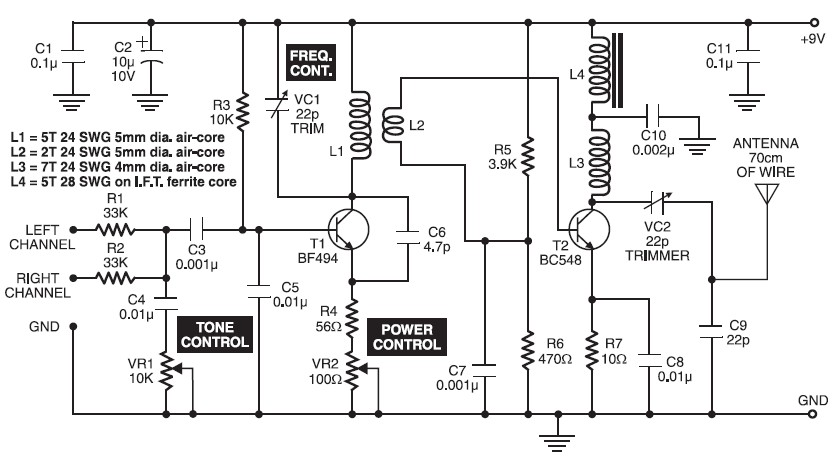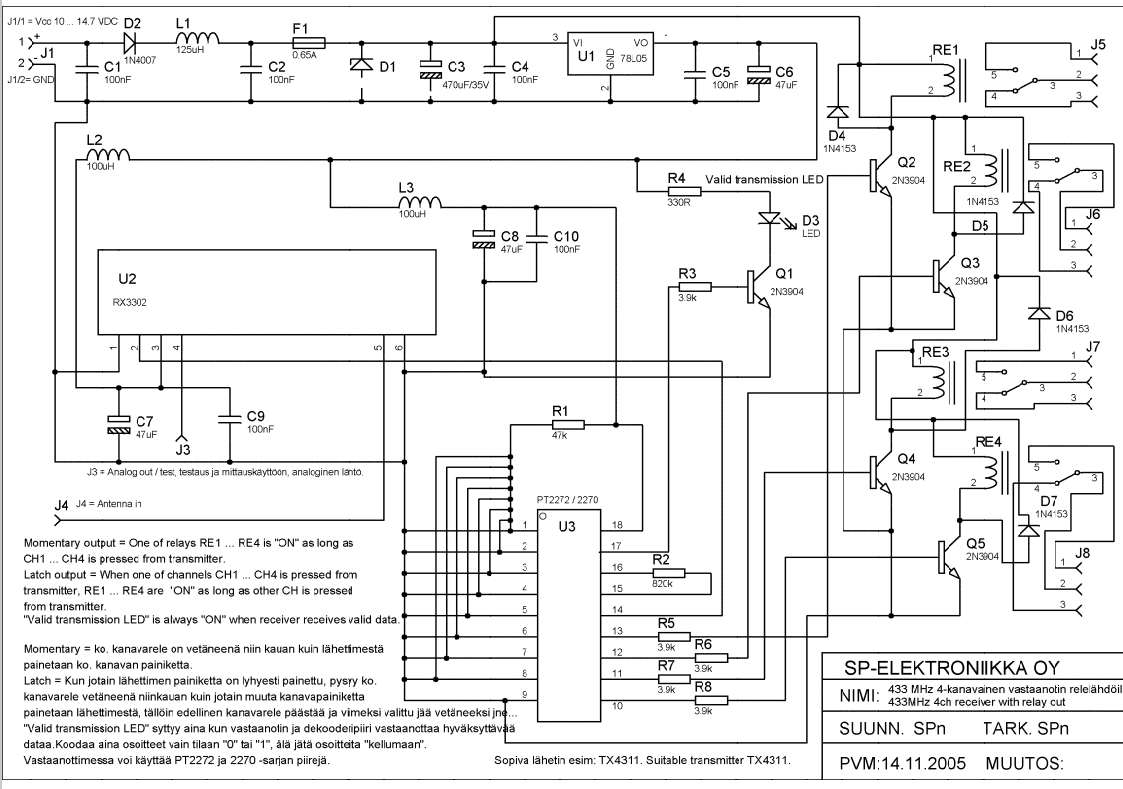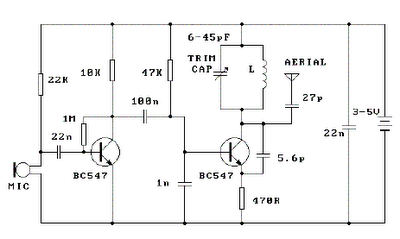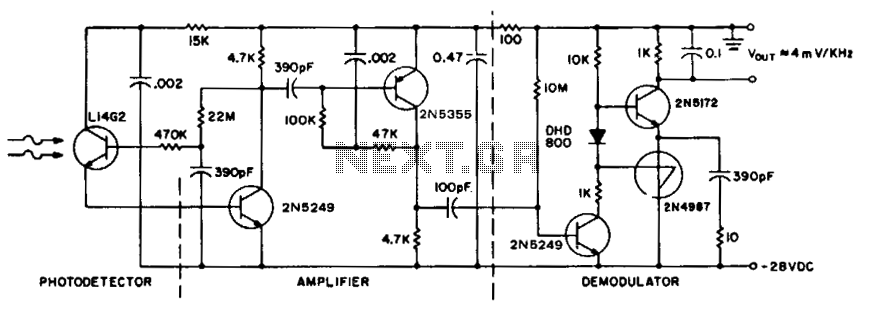
2 VALVE TRANSMITTER
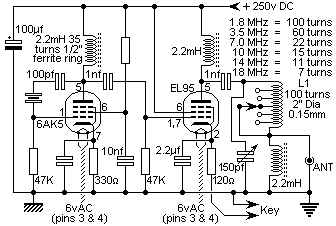
This transmitter is highly stable and can deliver up to seven watts of power using the specified components and tubes. The use of valves should not deter users, as they are straightforward to work with, and many valves can be found inexpensively at radio rallies due to their obsolescence. A variety of valves are available if the specific type is not a concern. The circuit diagram of the transmitter, along with coil winding details, is provided. The oscillator is a simple untuned Pierce oscillator that operates at the fundamental frequency of the crystal. A 25 pF variable capacitor connected between the grid of the first valve and ground allows for slight pulling of the final frequency, although this feature may not be utilized. The RF choke in the anode of the two valves consists of 34 turns of enameled wire wound on a 1/2" ferrite ring (2.2 mH). The output tank circuit is wound on a 2" diameter plastic conduit tube, aiming to maximize the number of wire turns within the desired frequency band. The output tuning capacitor should typically be set to about 10% when selecting the tapping for a specific band. The cathode resistor and 2.2 µF capacitor produce a favorable keying envelope for the keyed output. When the key is off, approximately 100 volts DC is present across the 2.2 µF capacitor, necessitating a component rated above 100 volts. Due to the high voltage, a CMOS keyer circuit should not be used without appropriate buffering. The 2.2 µF capacitor can be sourced from old telephones, as they often contain a 2.2 µF 250V non-electrolytic capacitor. The chassis is constructed from aluminum plate, drilled as shown. An additional hole is required to connect the PA anode to the tuning coil. If this connection is made using the output coupling capacitor beneath the chassis, high DC voltages will be avoided above the chassis. The mains input terminals must be adequately protected to prevent contact with the mains. The rear panel of the transmitter includes sockets for connection to the power supply (PSU), enabling the finished transmitter to serve as a high-voltage PSU for other projects. The front panel remains uncluttered, featuring only two controls: a BAND switch and a TUNE control. Two additional switches are included: one for powering on the PSU HT and another for keying the transmitter for tuning. The oscillator remains untuned, requiring only band selection (coil tapping) and peaking for maximum RF output. The selected valves have B7G bases and were chosen from the available components. Virtually any pentode valve can be employed in this circuit; for instance, an EL84 can deliver over ten watts, while the specified valves provide seven watts across a frequency range of 3.5 to 30 MHz. If a different tube is used, it is essential to verify the screen voltage; if it is below 250 volts, a resistor will be needed in the screen supply to the valve. The output tank coil should be constructed as illustrated. In this instance, 40 turns were required, but an earlier version using a smaller diameter tube needed 58 turns (3.5 MHz). Leave enough space for 65 turns (3.5 MHz) and then remove turns to reach the lowest desired frequency. Adjust the tappings to achieve full power on each band with only 10% of the tuning capacitance in use. The coil can be tapped easily by masking adjacent turns with tape, scraping, and soldering as shown in the accompanying photograph. To support the 1.8 MHz band, additional turns can be added, either by utilizing the full 100 turns or by incorporating a smaller coil in series with the main coil.
The schematic of this transmitter circuit emphasizes a straightforward design that leverages readily available components. The Pierce oscillator design is favored for its simplicity and reliability, providing a stable frequency source for RF applications. The RF choke, designed with precise turns and wound on a ferrite core, ensures efficient RF signal handling while minimizing losses. The output tank circuit's construction on a plastic conduit allows for easy adjustments and optimizations, crucial for achieving desired performance across multiple frequency bands. The careful selection of capacitors and resistors in the circuit design aids in managing high voltages safely, while also enhancing the keying performance of the transmitter. The layout of the chassis is purposefully designed for accessibility and safety, ensuring that all high-voltage components are adequately shielded. The inclusion of a PSU connection further enhances the functionality of the device, making it a versatile tool for various RF projects. Overall, this transmitter design exemplifies a balance of simplicity, efficiency, and adaptability, suitable for both amateur radio enthusiasts and educational purposes.This transmitter is very stable and will deliver up to seven watts of power with the components and tubes shown. Do not be put-off by valves as they are VERY easy to work with and it seems that there are quite a few valves around.
Because no-one wants these obsolete things they may be bought for next to nothing at radio rally`s. If you are not too particular what type of valve you want then there are lots of valves available. Above is the circuit of the transmitter including the coil winding information. The oscillator is a simple untuned Pierce oscillator which will oscillate at the fundamental frequency of the crystal. A 25pf variable capacitor between the grid of the first valve and earth will allow the final frequency to be "pulled" a little but I never used this facility.
The RF choke in the anode of the two valves is made up of 34 turns of enamelled wire wound on a 1/2" ferrite ring (2. 2mH). The output tank circuit is wound on a piece of 2" dia plastic conduit tube. The object is to have as many turns of wire in circuit as it is possible to have on the band of interest.
The output tuning capacitor should normally be set to about 10% when selecting the tapping for any particular band. The cathode resistor and 2. 2uf capacitor give quite a nice keying envelope to the keyed output. When the key is UP (off) there is about 100 volts DC across the 2. 2uf so this component must be rated in excess of 100v. Because of the high voltage you should NOT use a CMOS keyer circuit without suitable buffering. I obtained my 2. 2uf capacitor from an old telephone because they nearly always have a 2. 2uf 250v non-electrolytic capacitor somewhere in the circuit. The chassis is built using aluminium plate, drilled as shown above. An extra hole must be added to pass the connection from the PA anode to the tuning coil. If this connection is made using the output coupling capacitor under the chassis then there will be no high DC voltages above the chassis.
The mains input terminals must be suitably protected to prevent contact with the mains input. Here is the rear panel of the transmitter. I also mounted sockets for connection to the PSU so that the finished transmitter is also a high voltage PSU for other projects. The front panel is very uncluttered having only two controls; BAND switch and TUNE. I also added two switches, one to switch on the PSU HT and the other to key the TX for tuning purposes.
The oscillator is un-tuned so the only tuning procedure required is to select the band (coil tapping) and peak it for maximum RF output. The valves used were selected because they had B7G bases and were the first I put my hand on when I reached into my junk-box.
Virtually any pentode valves will work in this application. An EL84, for example, will deliver over ten watts in this circuit but the valves quoted will deliver seven watts from 3. 5 to 30 MHz. If you should use another tube then don`t forget to check the screen voltage. If it is less than 250v then you will need a resistor in the screen supply to the valve. The output tank coil should be built as shown. I only needed 40 turns on this one but on an earlier version I used a slightly smaller diameter tube and needed 58 turns (3.
5MHz). Leave space for 65 turns (3. 5MHz) then remove turns to achieve the lowest frequency you want to use. Adjust the tappings so that you achieve full power on each band with only 10% of the tuning capacitance in circuit. The coil can be easily tapped by masking adjacent turns with tape then scraping and soldering as shown in the photograph.
If you want to add more turns to support the 1. 8MHz band then you could either use the full 100 turns or add another (smaller) coil in series with the main coil. 🔗 External reference
The schematic of this transmitter circuit emphasizes a straightforward design that leverages readily available components. The Pierce oscillator design is favored for its simplicity and reliability, providing a stable frequency source for RF applications. The RF choke, designed with precise turns and wound on a ferrite core, ensures efficient RF signal handling while minimizing losses. The output tank circuit's construction on a plastic conduit allows for easy adjustments and optimizations, crucial for achieving desired performance across multiple frequency bands. The careful selection of capacitors and resistors in the circuit design aids in managing high voltages safely, while also enhancing the keying performance of the transmitter. The layout of the chassis is purposefully designed for accessibility and safety, ensuring that all high-voltage components are adequately shielded. The inclusion of a PSU connection further enhances the functionality of the device, making it a versatile tool for various RF projects. Overall, this transmitter design exemplifies a balance of simplicity, efficiency, and adaptability, suitable for both amateur radio enthusiasts and educational purposes.This transmitter is very stable and will deliver up to seven watts of power with the components and tubes shown. Do not be put-off by valves as they are VERY easy to work with and it seems that there are quite a few valves around.
Because no-one wants these obsolete things they may be bought for next to nothing at radio rally`s. If you are not too particular what type of valve you want then there are lots of valves available. Above is the circuit of the transmitter including the coil winding information. The oscillator is a simple untuned Pierce oscillator which will oscillate at the fundamental frequency of the crystal. A 25pf variable capacitor between the grid of the first valve and earth will allow the final frequency to be "pulled" a little but I never used this facility.
The RF choke in the anode of the two valves is made up of 34 turns of enamelled wire wound on a 1/2" ferrite ring (2. 2mH). The output tank circuit is wound on a piece of 2" dia plastic conduit tube. The object is to have as many turns of wire in circuit as it is possible to have on the band of interest.
The output tuning capacitor should normally be set to about 10% when selecting the tapping for any particular band. The cathode resistor and 2. 2uf capacitor give quite a nice keying envelope to the keyed output. When the key is UP (off) there is about 100 volts DC across the 2. 2uf so this component must be rated in excess of 100v. Because of the high voltage you should NOT use a CMOS keyer circuit without suitable buffering. I obtained my 2. 2uf capacitor from an old telephone because they nearly always have a 2. 2uf 250v non-electrolytic capacitor somewhere in the circuit. The chassis is built using aluminium plate, drilled as shown above. An extra hole must be added to pass the connection from the PA anode to the tuning coil. If this connection is made using the output coupling capacitor under the chassis then there will be no high DC voltages above the chassis.
The mains input terminals must be suitably protected to prevent contact with the mains input. Here is the rear panel of the transmitter. I also mounted sockets for connection to the PSU so that the finished transmitter is also a high voltage PSU for other projects. The front panel is very uncluttered having only two controls; BAND switch and TUNE. I also added two switches, one to switch on the PSU HT and the other to key the TX for tuning purposes.
The oscillator is un-tuned so the only tuning procedure required is to select the band (coil tapping) and peak it for maximum RF output. The valves used were selected because they had B7G bases and were the first I put my hand on when I reached into my junk-box.
Virtually any pentode valves will work in this application. An EL84, for example, will deliver over ten watts in this circuit but the valves quoted will deliver seven watts from 3. 5 to 30 MHz. If you should use another tube then don`t forget to check the screen voltage. If it is less than 250v then you will need a resistor in the screen supply to the valve. The output tank coil should be built as shown. I only needed 40 turns on this one but on an earlier version I used a slightly smaller diameter tube and needed 58 turns (3.
5MHz). Leave space for 65 turns (3. 5MHz) then remove turns to achieve the lowest frequency you want to use. Adjust the tappings so that you achieve full power on each band with only 10% of the tuning capacitance in circuit. The coil can be easily tapped by masking adjacent turns with tape then scraping and soldering as shown in the photograph.
If you want to add more turns to support the 1. 8MHz band then you could either use the full 100 turns or add another (smaller) coil in series with the main coil. 🔗 External reference
